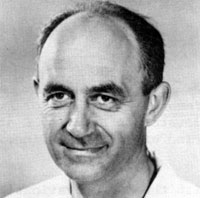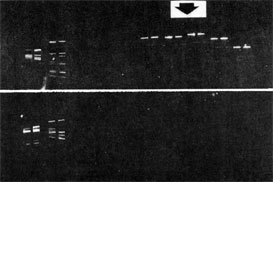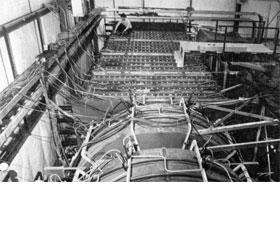A Time for Dedication...
At the time in its history when it is to be dedicated to an official position in high energy physics research in the United States, the National Accelerator Laboratory steps into deep traditions both of scientific achievement and of American concern for human welfare.
Enrico Fermi for whom the Laboratory will be named on Saturday, May 11, represents the highest of scientific tradition - the dedication, the brilliance that yields great new discoveries. Fermi's colleague, Herbert L. Anderson. described Fermi's achievement in this tribute on December 1, 1954:
"The eternal scholar, Fermi was always eager to learn. He was always grateful when he found out something new. What he learned he felt he should enrich. Having enriched what he learned he felt he should teach to others. Thus, he prepared the fertile ground out of which arose the new solutions and new ideas which kept his subject bright, fresh, and exciting...To explore the mysteries of nature with Enrico Fermi was always a great adventure and a thrilling experience. He had a sure way of starting off in the right direction, of setting aside the irrelevancies, of seizing all the essentials and proceeding to the core of the matter. The whole process of wresting from nature her secrets was for Fermi an exciting sport which he entered into with supreme confidence and great zest..."
Dr. Anderson, of the University of Chicago, is one of the collaborators in Experiment #98 at NAL together with experimenters from Harvard University, Oxford University, and the University of Illinois, as mentioned in the last issue of The Village Crier.
It was appropriate that another experiment, #1-A at the National Accelerator Laboratory, should study interactions of neutrinos, the particles which form the backbone of Fermi's famous work illuminating weak interactions. Fermi would no doubt be greatly enthused at the results indicating that this experiment may be opening a door comparable to the first description of electromagnetic phenomena 100 years ago.
Experiment 1-A represents a collaboration of experimenters from Harvard University, University of Pennsylvania, University of Wisconsin, and the National Accelerator Laboratory. Writing about the experiment recently. Dr. David Cline of the University of Wisconsin, spokesman for the group, notes:
"Until the last year or so the known similarities between weak and electromagnetic interactions were of a nature that did not compel one to imagine any deep connection between these two forces. In fact, it was thought that the electric charge carried by the currents in electromagnetic interactions was always different from the electric charge of the current that controlled the weak interactions.
"Experiments at CERN and NAL in the past year or so seem to have observed a new process and have inferred that a current also mediates the weak interaction which has the same electric charge as that of the electromagnetic interaction or in other words a 'weak neutral current.' The NAL experiment has also shown that the weak force is growing stronger at high energies and it is expected that at still higher energies than available with the existing NAL machine, the weak force will become stronger than the electromagnetic force.
"With these observations two important differences between weak and electromagnetic interactions are removed and it appears more plausible that these interactions may somehow have a common origin...It is possible that the study of weak and electromagnetic interactions is now entering the analogous phase of Oersted and Faraday in electromagnetism. Hopefully it will not take 42 years for a modern Maxwell to clarify the situation."
Dr. Benjamin W. Lee, head of NAL's Theoretical Physics department, and an authority on the search for the weak neutral current, commented recently:
"Experimental verification by one of the experiments now running at the National Accelerator Laboratory, and at CERN, of the existence of the neutral current is a cornerstone in our theoretical understanding of the workings of weak interactions. This is an extension of Fermi's original idea on beta decay. It is gratifying that the Laboratory has already accomplished this feat even before the dedication."
Other experiments in the Neutrino Area promise startling new insights into the realms being probed by Experiment 1-A. Indeed it is clear that the new energy ranges at NAL will reveal the horizons envisaged by the Joint Committee on Atomic Energy when it urged the construction of the NAL accelerator in 1965.
Enrico Fermi came to the United States from Italy in 1939, to escape the political pressures of the time. He was warmly received by his American colleagues and the U.S. benefited greatly from his work here. About thirty years later, in 1968, leaders of the National Accelerator Laboratory (the largest atomic research facility to be built since Fermi's death) carried on the tradition of the American scientific community's concern for human welfare. Dr. Robert R. Wilson and Dr. Edwin L. Goldwasser announced that this Laboratory would operate on a basic "Policy Statement on Human Rights." The Policy stated:
"It will be the policy of the National Accelerator Laboratory to seek the achievement of its scientific goals within a framework of equal employment opportunity and of a deep dedication to the fundamental tenets of human rights and dignity."
Dr. Wilson called on employees of the Laboratory to renew their dedication to this policy In April, 1974. He said in a letter to employees:
"This is an appropriate time for us to rededicate ourselves to some of the principles that are most basic to the style of this Laboratory."
The Policy Statement on Human Rights which accompanied Dr. Wilson's letter is reprinted here in the spirit of the time at the Fermi National Accelerator Laboratory when science and men will become dedicated to the newest American scientific endeavor.
The New York Times, in an editorial after Enrico Fermi's death in 1954, noted this same combination of men and science in Fermi's life. The following appeared in the Times:
"Much can be justly said of Dr. Fermi as a great teacher of science, as a loyal friend to his colleagues and as a source of inspiration for the generation of physicists which came after him. But for the great majority of us who are not physicists one aspect of his career deserves special attention. It was in Italy that Dr. Fermi was born and educated and there he achieved his first brilliant successes. But when he was at the height of his power, in 1938 his native land was ruled by Mussolini whose anti-Semitic campaign posed a threat which reached into Dr. Fermi's family. To escape this totalitarian oppression the Fermi family came to this land of freedom and then repaid us for that sanctuary in million fold measure.
"On this day after Dr. Fermi's death we may well meditate this lesson of his career and resolve anew to keep bright the light of freedom for all within these shores."*
*Copyright 1954 by The New York Times Company. Reprinted by permission.





